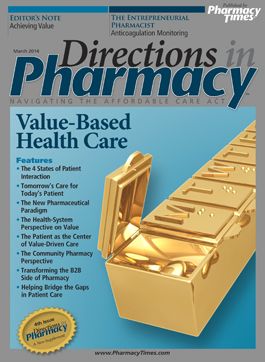Publication
Article
Pharmacy Practice in Focus: Oncology
How Do You Define Value in Health Care?
This edition of Directions in Pharmacy addresses the value-based health care model through the eyes of pharmacy-and focuses on its challenges and opportunities.

You’ll get just about everyone’s attention with the terms “value-based” and “value-driven”—and what first comes to mind are the literal cost savings in dollars and cents. In health care today, this vocabulary surfaces in just about every discussion about health care and in every setting, from medical practices to hospitals to pharmacies. With the implementation of the Affordable Care Act in progress, cost savings have not yet been realized as the health care community adjusts to new realities and regulations.
This edition of Directions in Pharmacy addresses the value-based health care model through the eyes of pharmacy—and focuses on its challenges and opportunities. While all medical professionals are affected, perhaps pharmacists are the key to its potential success because if, and only if, medication adherence is achieved on a global scale will health outcomes be positively affected and those all-important dollars be saved down the line.
Things are changing rapidly in health care, and as our guest editor Troy Trygstad, PharmD, PhD, MBA, notes, “That paradigm is changing dramatically now that stakeholders are choosing a wider-angle view resulting from health care reform’s shared risk corridors and emphasis on value over volume.” The pharmacist—whether from a community, health-system, or specialty pharmacy setting—is in the unique position of being able to perhaps effect the greatest amount of change, and, ultimately, cost savings. Collaboration among the entire health care team, which is evolving in the new value-based models of care delivery, showcases the special value and talents pharmacists bring to the process.
So, how do you define value? Dr. Trygstad says, “Value is defined as the amount of benefit received for the cost relative to other services that produce similar benefits. Yet for the vast majority of health care services, the benefit isn’t realized until after the encounter. Thus, follow-up, adjustment, and reinforcement of the patient’s care plan are essential for realizing the benefits coming from the investment made by the patient or the payer in the encounter.”
What he says makes sense in today’s environment. It’s all about the patient and the patient’s continued experiences with all members of the health care team. And pharmacists’ expertise in medication management, plus their accessibility in the community, point to an ever-expanding role for the pharmacist in the health and wellness of the nation’s population.
Thank you for reading!
Mike Hennessy
Chairman/Chief Executive Officer







